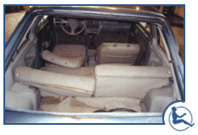SEAT BACKREST COLLAPSE

 In a rear impact accident, the occupant's inertial force against a seat's weak backrest will cause it to recline and collapse and twist rearward. The occupant will "ramp up" the backrest and slam head-first into the rear seat or out through the rear window. There's also the risk of the parent slamming rearward into their child during a rear-impact accident, and causing severe to fatal injuries. In a rear impact accident, the occupant's inertial force against a seat's weak backrest will cause it to recline and collapse and twist rearward. The occupant will "ramp up" the backrest and slam head-first into the rear seat or out through the rear window. There's also the risk of the parent slamming rearward into their child during a rear-impact accident, and causing severe to fatal injuries.
 Many front seat backrests are only minimally supported by a recliner mechanism on the outboard side only, with the inboard side being a "free pivot" that offers no support at all. Some recliner mechanisms are very minimal, with shallow engagement of the pawl and teeth adjuster mechanism. Supporting both backrest arms with stronger recliner mechanisms, outboard and inboard , could strengthen the backrest in a balanced manner, to at least 5,000 lbs., similar to what seatbelts offer in frontal crashes. Many front seat backrests are only minimally supported by a recliner mechanism on the outboard side only, with the inboard side being a "free pivot" that offers no support at all. Some recliner mechanisms are very minimal, with shallow engagement of the pawl and teeth adjuster mechanism. Supporting both backrest arms with stronger recliner mechanisms, outboard and inboard , could strengthen the backrest in a balanced manner, to at least 5,000 lbs., similar to what seatbelts offer in frontal crashes.
 
 FMVSS 207 only requires a "slow pull" of 20 times the weight of the seat itself, with no test dummy on the seat, and no crash test... thus it's much too minimal and unrealistic to ensure safe seat performance. FMVSS 207 only requires a "slow pull" of 20 times the weight of the seat itself, with no test dummy on the seat, and no crash test... thus it's much too minimal and unrealistic to ensure safe seat performance.
There should be an immediate upgrading of FMVSS 207 to require that seat performance be evaluated with crash test dummies on the seat, including 95th-percentile large-size adult test dummies, in 50 mph rear-impact crash tests by a 4,000-lbs. moving barrier, to better simulate what happens in real-world collision accidents. Such crash tests should also include the placement of a child size test dummy on the rear seat.
|